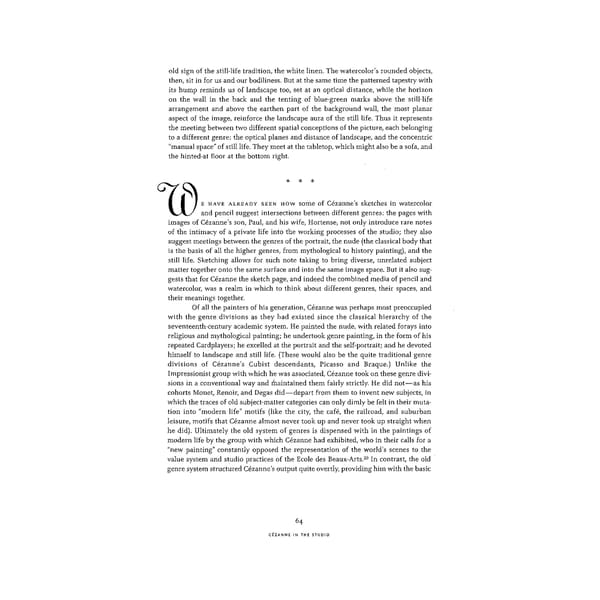old sign of the still-life tradition, the white linen. The watercolor's rounded objects, then, sit in for us and our bodiliness. But at the same time the patterned tapestry with its hump reminds us of landscape too, set at an optical distance, while the horizon on the wall in the back and the tenting of blue-green marks above the still-life arrangement and above the earthen part of the background wall, the most planar aspect of the image, reinforce the landscape aura of the still life. Thus it represents the meeting between two different spatial conceptions of the picture, each belonging to a different genre: the optical planes and distance of landscape, and the concentric "manual space" of still life. They meet at the tabletop, which might also be a sofa, and the hinted-at floor at the bottom right. wE HAVE ALREADY SEEN HOW some of Cezanne's sketches in watercolor and pencil suggest intersections between different genres: the pages with images of Cezanne's son, Paul, and his wife, Hortense, not only introduce rare notes of the intimacy of a private life into the working processes of the studio; they also suggest meetings between the genres of the portrait, the nude (the classical body that is the basis of all the higher genres, from mythological to history painting), and the still life. Sketching allows for such note taking to bring diverse, unrelated subject matter together onto the same surface and into the same image space. But it also sug- gests that for Cézanne the sketch page, and indeed the combined media of pencil and watercolor, was a realm in which to think about different genres, their spaces, and their meanings together. Of all the painters of his generation, Cézanne was perhaps most preoccupied with the genre divisions as they had existed since the classical hierarchy of the seventeenth-century academic system. He painted the nude, with related forays into religious and mythological painting; he undertook genre painting, in the form of his repeated Cardplayers; he excelled at the portrait and the self-portrait; and he devoted himself to landscape and still life. (These would also be the quite traditional genre divisions of Cezanne's Cubist descendants, Picasso and Braque.) Unlike the Impressionist group with which he was associated, Cézanne took on these genre divi- sions in a conventional way and maintained them fairly strictly. He did not—as his cohorts Monet, Renoir, and Degas did—depart from them to invent new subjects, in which the traces of old subject-matter categories can only dimly be felt in their muta- tion into "modern life" motifs (like the city, the café, the railroad, and suburban leisure, motifs that Cézanne almost never took up and never took up straight when he did). Ultimately the old system of genres is dispensed with in the paintings of modern life by the group with which Cézanne had exhibited, who in their calls for a "new painting" constantly opposed the representation of the world's scenes to the value system and studio practices of the Ecole des Beaux-Arts.20 In contrast, the old genre system structured Cezanne's output quite overtly, providing him with the basic 6 4 CÉZANNE IN THE STUDIO
 Cézanne in the Studio: Still Life in Watercolors Page 78 Page 80
Cézanne in the Studio: Still Life in Watercolors Page 78 Page 80